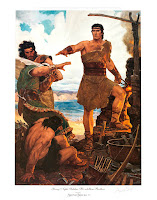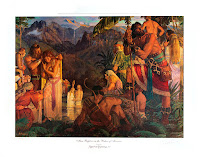Missionary work involves a variety of expectations, but here I'm focusing solely on the expectations raised by the missionary edition of the Book of Mormon.
Over the years, the official editions of the Book of Mormon have contained sets of illustrations. I have copies of many of these that I'll use to make this important point:
The expectations of missionaries, investigators and members are set largely by these illustrations.
The illustrations that accompany the official edition of the Book of Mormon are tremendously influential. I suspect that far more people look at the illustrations than read the text. Probably 100 times more.
Obviously, the message in the text is ultimately the most important, but unless people read the text,they don't get the message. If the illustrations convey ideas that contradict the text (and Church history), then they cause confusion.
The fact that these illustrations have changed over the years shows that they can be changed again. At the end of this post, I have a suggestion along those lines.
The history of these illustrations reflects a shift from a hemispheric model (the one that Friberg apparently intended) to the limited geography two-Cumorah Mesoamerican model that modern scholars support. For example, notice that the earlier editions showed both Mormon and Moroni at the New York Cumorah, while the newer editions show only Moroni in New York.
I suggest it's time to shift back to a one-Cumorah model, based on New York.
__________________________
I have a copy of a 1961 Book of Mormon that contains the following illustrations at the front of the book:
 The caption: When Jesus Christ organized His Church, He called and ordained his disciples.
The caption: When Jesus Christ organized His Church, He called and ordained his disciples.Caption: The Prophet Joseph Smith. He translated the ancient writings inscribed on gold plates from which the first edition of the Book of Mormon was published in 1830.
Caption: The Hill Cumorah, near Manchester, New York where Joseph Smith obtained the gold plates from which the Book of Mormon was translated.
Caption: The beautiful monument to the Book of Mormon Prophet Moroni was erected on the top of the Hill Cumorah in July, 1935.

Caption: Gold tablet found in Persia in 1961, dating to the time of Darius II (Fourth Century B.C.)...
Caption: Ancient copper and bronze tools dated from the Book of Mormon period.
Caption: Gold plates from Peru fastened together with gold rings. Ancient Americans were skilled craftsmen in gold and precious metals.
Caption: Textiles from Peru, dated from the Book of Mormon period.
Caption: Egyptian-like murals found on temple walls in Mexico.
Caption: Looking across the main plaza of Monte Alban (sacred mountain). This city dates back to 800 years before Christ.
Caption: Temple of the Cross in Mexico. This temple, believed to have been erected during the Maya Classic Period, contains the famous Cross of Palenque. Many archaeologists now agree that these artistic masterpieces date back to the beginning of the Christian era.
In addition to these illustrations, eight of the twelve Arnold Friberg paintings are interspersed in the text.
The exact same set of illustrations are in the 1980 English edition I'm looking at right now.
[Note: I also have a 1973 Spanish edition that contains the same illustrations except it substitutes Machu Picchu for Monte Alban. I suspect the reason is to show a hemispheric model that would appeal to people in South America.]
___________________________
The 1981 English edition changed the illustrations to what we have now, both in print and on lds.org
here. This is the edition that added the subtitle "Another Testament of Jesus Christ" to the cover.
If I'm an investigator, missionary, or member, here's what I take away from these illustrations. First, Christ is the most important (the first illustration) and the Heinrich Hoffman painting depicts the traditional Christ accepted by Christianity generally. Awesome.
Second, Joseph Smith. Makes sense.
Third, finding the Liahona in the Arabian desert. One of the best Friberg paintings, set in the right place, and emphasizing a key element of the text. Nice.
Fourth, arriving at the promised land. So long as I don't realize that Friberg intentionally used a bird species that exists only in Central America, and so long as I don't notice the high mountains in the background, the painting is ambiguous enough that Lehi could have landed almost anywhere in the Americas. Okay, but not great.
Fifth, the waters of Mormon in the depths of a thick jungle featuring high mountains. Hmm, now it's inescapable. I have to conclude that the Book of Mormon took place in Central America somewhere (or maybe somewhere in the Andes). Let's say, not good because it conveys a specific setting the text does not support. Worse, it endorses the scholars' two-Cumorah theory that rejects Letter VII and Oliver Cowdery, one of the Three Witnesses.
Sixth, Samuel the Lamanite on the Mayan walls of the city of Zarahemla. Now there's no doubt about it. As a reader, I have to believe the Book of Mormon took place in Central America. But when I read the text, I'll be seriously disappointed and confused to discover the text never mentions huge stone pyramids and temples. It never mentions jungles. And when the answer to my obvious questions about Cumorah is that there are actually two Cumorahs, I'll become even more confused.
Seventh, Jesus Christ visits the Americas by John Scott. This painting combines a variety of ancient American motifs to convey the idea (I think) that Christ visited people throughout the Americas. This is a reasonable inference from the text. (I like to think the clouds represent North America, but it would be far better to show something actually from North America, such as an earthwork, that is described in the text. Of course, the text never mentions pyramids, stone buildings, or even high mountains where the Nephites lived.) The biggest problem with including this illustration is the inference that Christ is visiting the Nephites in Central America. The painting is
incorrectly labeled "Christ teaching Nephites" on lds.org, for example. If the webmaster at lds.org misunderstands the painting, surely investigators, missionaries, and members make the wrong inference as well.
Eighth, Moroni burying the plates. Awesome. Except the caption doesn't say where Moroni is burying them; it doesn't mention Cumorah or New York. The Introduction says Moroni "hid up the plates in the Hill Cumorah," so as a reader, I infer this painting is supposed to be the New York hill. But then how could all the other events take place somewhere in Central America? More confusion, especially when the explanation I'm given is the two-Cumorah theory.
__________________
My suggestion.A member, missionary, or investigator who looks at the official edition of the Book of Mormon, online or in print, will naturally turn to these illustrations and take away the message that the Book of Mormon events occurred in Central America. There is really no other feasible conclusion to be drawn from the illustrations.
But the illustrations contradict the text itself in many ways.
The only certain connection we have between the Book of Mormon and the modern world is the Hill Cumorah. People who read the text should not be influenced by depictions of huge Mayan temples, massive stone walls, jungles, and the like. Artistic representations should rely on the text. Some of the Arnold Friberg paintings are set in places that conform to the text; i.e., Lehi in Arabia, brother of Jared on a high mountain, Mormon and Moroni on the New York Hill Cumorah. Others, however, have created expectations among members and nonmembers alike that simply cannot be reconciled with the text or satisfied in the real world.
The sooner they are replaced with text-based illustrations, the better.
Given the existing artwork, here's what I would like to see in the way of Book of Mormon illustrations:

Awesome.
I'd like to go back to the emphasis on the Hill Cumorah in New York, both because of its central role in the restoration, and because of its importance in the text. This spot, in New York, is where the Nephite and Jaredite civilizations came to an end.
I'd like to see a quotation from Oliver Cowdery's Letter VII here in the caption. After all, Oliver's testimony as one of the three witnesses is already in the introductory material. Maybe instead of the statue, we could have a photo of the valley to the west where the final battles took place.
Keep this illustration of Lehi and the liahona because it is consistent with the text; i.e., a Middle-Eastern setting.

Add this one back because it's an important story and shows the coast of the Arabian peninsula.
Add this one because it is important to show actual sheep from the text instead of the tapirs and agouti in Central America, although the tropical plants are still problematic.
Add this one back because of how important the story is and the setting, somewhere in Asia, doesn't matter.
Add this one back because it shows both Mormon and Moroni at the Hill Cumorah in New York. This is eliminates any confusion about Cumorah. It reaffirms what Oliver Cowdery wrote in Letter VII.
Keep this one because it shows Moroni burying the plates in New York in the stone and cement box he constructed, away from the repository of the Nephite records that his father Mormon concealed elsewhere in the hill.
_____________________________________
Illustrations that are consistent with the text can help encourage people to read the text and engage with it. Illustrations that are inconsistent with the text--i.e., illustrations of jungles and massive stone pyramids--are confusing and off-putting. When people discover that illustrations in the official editions rely on the scholars' two-Cumorah theory, it's even worse. The scholarly theories that the Hill Cumorah is actually anywhere but in New York, and that Joseph Smith and Oliver Cowdery were speculating about all of this, are hardly conducive to faith.
If we could have a consistent narrative based on the New York setting for the Hill Cumorah, and eliminate the confusing images based on Central America, the message of the text would be free from distractions, which would enhance understanding and faith. 
















































